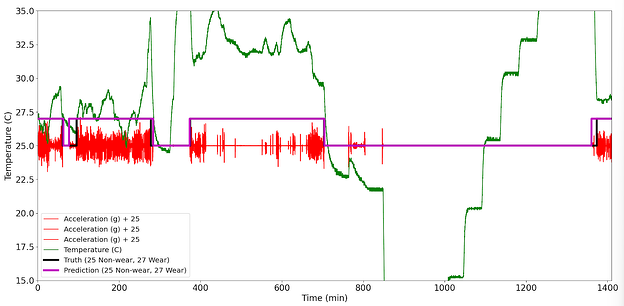The temperature of the human body is tightly regulated and stays within a narrow range between 36 and 38 degrees Celsius under healthy conditions. Within this range, body temperatures fluctuate in response to physiological and environmental variables. It is well established that the circadian clock impacts body temperature, with cooling typically accompanying sleep. A body temperature above or below the normal range can be an indication of illness. Abnormal regulation of body temperature during sleep can also provide prodromal markers of multiple mental, physical, and infectious diseases. Thus, assessments of body temperature can provide important information on a person’s health and physiology.
Body temperatures vary depending on the measurement location. Core temperatures measured from inside the body are less affected by environment variations and more directly linked to bodily physiology than peripheral temperatures. However, it is impractical to measure core body temperature continuously. Digital and wearable technologies have enabled the use of small temperature sensors, which provide a practical solution to continuously monitor temperature on the skin surface. With the upcoming release of the CentrePoint Insight Watch 2.0 (CPIW 2.0), ActiGraph has incorporated the ability to collect temperature data for the first time in our product line. We are excited about how this new capability will enhance and expand the suite of digital measures in our platform.
Our initial motivation for adding this capability is the ability for temperature to better inform wear detection, which is key to adherence monitoring and an essential post-processing step of digital endpoints. Actigraphy devices have traditionally used levels of motion data to detect whether or not they are being worn by study participants. However, episodes of non-wear time are sometimes difficult to distinguish from spans of sleep or sedentary periods based on motion data only. The detection of near-body temperature could add key information in these scenarios. Recent research has shown that a hybrid algorithm fusing both temperature and motion signals to detect wear periods can improve both sensitivity and specificity of the wear detection.

Figure 1 - Hybrid wear detection algorithm by fusing both accelerometer and temperature sensor in CPIW 2 device, based on Zhou et al, 2015.
At this time, ActiGraph does not support the use of near-body temperature for sleep scoring, detecting fever, or as indications of infectious diseases. Like all non-invasive temperature measures, the temperature ratings from the CPIW 2.0 can be influenced by environmental temperatures and should not be considered an equivalent measure of core body temperature. However, because of its ability to collect large amounts of continuous data on the individual, it is likely that the CPIW 2.0 could detect patterns of relative temperature changes. Our science team is working on sleep algorithms that take relative temperature changes, rather than the absolute temperature as input. More research work is needed to understand the potential of these individualized relative temperature changes for sleep scoring or to detect disease-related temperature abnormalities.
Interested in receiving more articles like this?